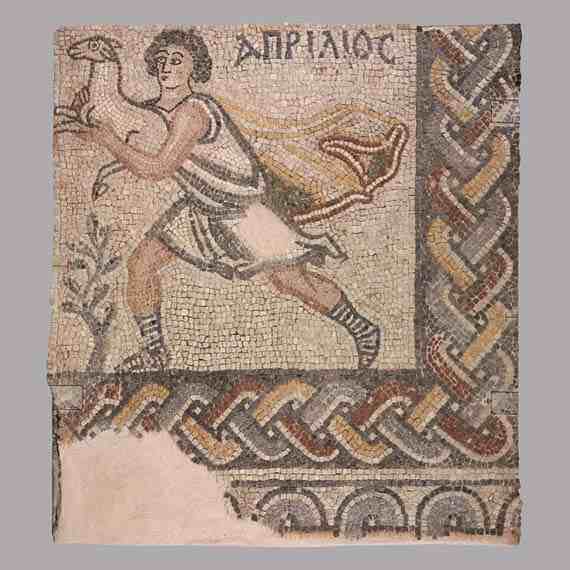The Kriophoria & Pastorialism
One line of departure I neglected to mention in my last post about Hermes Kriophoros is the image of the shepherd relating to months/seasons of the year. I should note first, however, that although every Hermes Kriophoros is a shepherd, not every shepherd is a Kriophoros. It seems we have Virgil to thank for connecting the pastoral tradition of poetry to the (highly idealized) landscape of Arkadia in his Eclogues. I think this is where some of the obfuscation takes place: so widespread were both the cult of Kriophoros and the poetic motif of the shepherd caring for this flock that some overlap is perhaps not far-fetched.
With this in mind, a further development of pastoral imagery is the shepherd with his flock as a calendrical motif representing March, April, May, or spring in general. Mosaics show this directly: on one from Thebes (c. 500 CE), a shepherd carries a lamb under the legend “APRILIOS” (April).

Lambs are born in the spring (like many species)–the “spring lamb” known to Easter and Passover celebrations. Coincidentally, the sun moves into Aries, the Ram, from late March to late April.
All in all, in deciding to establish a new festival modeled loosely on Tanagra’s Hermaia, April seems to be an opportune time for honoring Hermes Kriophoros. The last vestiges of winter will have cleared away. Young leaves will cloud the trees in a soft, tender green broken by blossoms. It’s a good time for celebrating the beauty of new life and invoking the God’s blessing upon it.
However–and this is a significant however–the celebrations that come with Hermes the Shepherd God speak to a very different conception of a festival calendar than the one I dare say many Hellenists are familiar with. Athens–mercantile, agricultural Athens–has always been the touchstone of so much of our knowledge about ancient Hellas, but the concerns forefronted in many of its festivals (I’m looking at you, Thesmophoria!) deal with farming and the grain crop. Pastoral and fiercely independent, Arkadia was a mountainous region known for its sheep and goat herding and we can likewise assume that its festival calendar reflected that. No less independent, Boiotia’s economy also rested heavily upon animal husbandry (1).
My festival calendar then is not the Athenian cycle that you’ll find repeated ad nauseam in textbooks on Greek religion or on Hellenion’s website. Where its festivals show common features that help reconstruct similar ritual activities, I’ll reference it. Otherwise, I think it’s time we think outside the classical-Athenian box.
Notes:
- Adkins, Leslie and Roy A. Adkins, Handbook to Life in Ancient Greece. OUP, 1997: 173-4.